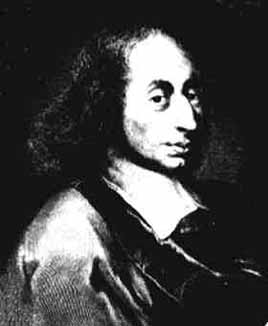
We'll look at some of Pascal's work below.
 |
Pascal started to work on geometry himself at the age of 12. He
rediscovered that the sum of the angles of a triangle are two right
angles. At the age of 16, Pascal discovered a number of Projective
Geometry theorems, including Pascal's Mystic Hexagon. In 1640, he
published his first work, Essay on Conic Sections. He invented the
first digital calculator to help his father with his tax-collecting. From
1646 onwards, Pascal began a series of experiments on atmospheric
pressure. By 1647 he showed that a vacuum existed. In 1653, he wrote a
treatise explaining Pascal's law of pressure. This treatise is the first
complete outline of a system of hydrostatics. Pascal was not the first to
study the Pascal triangle (and binomial coefficients), but he produced the
most important work on this topic and this led Isaac
Newton to discover the general binomial theorem for fractional and
negative powers. He and Pierre de
Fermat are the founders of Probability Theory.
We'll look at some of Pascal's work below. |
1
1 1
1 2 1
1 3 3 1
1 4 6 4 1
1 5 10 10 5 1
1 6 15 20 15 6 1
1 7 21 35 35 21 7 1
. . . . .
. . . . .
The next row is obtained by adding the adjacent terms of the previous row.
These numbers are the coefficients of the Binomial Theorem:

n! (pronounced "n factorial") is the product of the first n natural numbers. E.g. 3! = 6, 4! = 24. He found the Binomial Theorem for positive integer powers. The theorem was later generalized to real powers.
Problem of Points
The original problem posed to Fermat was:
Consider two players, A and B. A needs 2 points to win and B needs 3 points.
What is A's chance of winning over B's? Fermat's answer to this is A's 11/16 as
to B's 5/16. Pascal generalized this problem to: A needs m points to win,
whereas B needs n points to win; and his solution is that A's chance of winning
is
and B's chance of winning is the complement of this.

The equation of the cycloid with a cusp at the origin is
In parametric form, this is
x = a(t - sint)
y = a(1 - cost)
Return to Maths Homepage